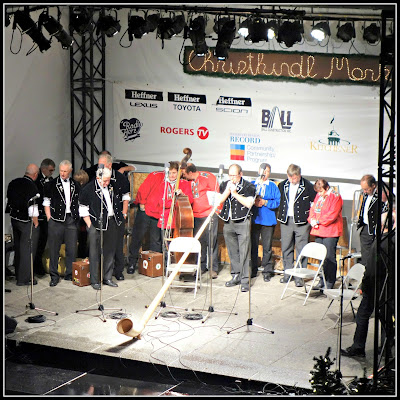 |
| Christkindl Christmas Market |
We attended the annual Christkindl Christmas market in our city this weekend. Our area was settled largely by German speaking immigrants a couple of centuries ago and while we are far more diverse now, Oktoberfest and the Christmas market are well attended events.
 |
| Traditional German band with an alpenhorn |
I asked a Hindu nurse at work if there were any December celebrations in her culture. She said no, but she planned to put up a Christmas tree and exchange gifts with friends and family. To her, it was a Canadian tradition she felt comfortable adopting. Other acquaintances are celebrating St. Nicholas Day tonight and tomorrow in the Dutch tradition. There was a Krampus run this weekend along with the Christmas market to celebrate some darker European Yuletide legends.
 |
| Krampus is here Catalonian Caganer (source) |
Catalonian nativity scenes feature a figure who is defecating in a corner or behind a tree. The “Caganer" or “pooper” is a symbol of fertility and good fortune in an agrarian society. He may also represent the fact that Jesus was a partaker of everything that is human. I work in an environment where regularity or irregularity is recorded and dealing with excrement is all in a day’s work. It is something common to all species who eat food, whether rich or poor, young or old, famous or infamous. It is part of our humanity.
In Mexico, Christmas posadas are community events where participants go from house to house looking for the Christ Child. In parts of Newfoundland, Mummers go from house to house looking for food and drink in exchange for music and dancing.
 |
| Joseph at the Christkindl Market |
I truly doubt that our nativity scenes depicting the birth of Jesus are even close to what really happened. In my mind, Mary and Joseph were likely staying with relatives in the autumn of the year. The lower part of the building housed the animals and the couple stayed there, as the guest room was occupied. They shared meals with others who were hospitable and generous. They may have been guests for days or weeks before the birth. Mary was not alone during labour but was attended by a local midwife and caring women. They were not isolated on a hill far from town but were part of the normal hum and rhythm of the community.
Legend and tradition have become the mainstay of our December celebrations with each culture interpreting the story according to their own history and perspective. Community is central to the celebration. I am fortunate to be able to participate in my community’s Christmas celebrations. Maybe someday I will have a chance to visit Spain and encounter a Caganer as part of their interpretation of the Christmas story.
Fascinating, Ruth! I was surprised a few years ago when I learned of the manger in the lower part of the house. It certainly does challenge the depictions I grew up with, and is fun to ponder. Your area sounds like such a diverse and stimulating one to celebrate the Christmas season in. I'm running too fast to blog, but am dying to get about 5 posts out there. Maybe during the Christmas break, which is coming up in 2 weeks for us...
ReplyDeleteYou certainly have access to various traditions. Makes life interesting.
ReplyDeleteNice post. I enjoyed reading about the other traditions. Was glad to read of the Hindu nurse celebrating Christmas as a Canadian tradition. Years ago, I think that would have been unheard of.
ReplyDeleteI like your interpretation of Mary and Joseph staying with relatives and Mary being attended by a mid-wife. So much more comforting that the old story.